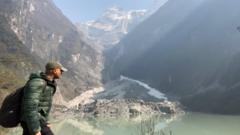Residents near the Sarandí canal in Buenos Aires were alarmed when the normally clear water transformed into a vivid red hue, prompting environmental investigations. Speculations point toward textile dye or toxic waste from nearby factories, raising issues of industrial pollution in the area.
Red Alert: Buenos Aires Canal Stuns Residents with Unusual Coloration

Red Alert: Buenos Aires Canal Stuns Residents with Unusual Coloration
The Sarandí canal near Buenos Aires raised concerns among locals after it unexpectedly turned a striking red due to alleged industrial waste dumping.
On Thursday, a canal within a suburb of Buenos Aires, Argentina, drew immediate attention when it turned a vivid red, alarming the community surrounding it. The unusual scene has residents posting pictures and videos online, showcasing the startling color as it flowed into the Rio de la Plata—a vital estuary neighboring an ecological reserve.
Local media reports have suggested that the canal's transformation in color could be attributed to the illicit dumping of textile dyes or chemical waste from nearby industrial facilities. The Environment Ministry has acted swiftly, announcing that water samples from the Sarandí canal have been collected to establish the exact cause behind this remarkable change.
As the day progressed, reports indicated that the intense hue started to fade, potentially signaling a change in the external conditions or the waste's dilution. Area residents have long suspected that numerous local industries have been discharging harmful effluents into the waterway—a crucial fact, noting that the canal traverses a region densely populated with leather processing and textile factories about 10 km (6 miles) from downtown Buenos Aires.
Silvia, a resident living near the canal, expressed her worries to C5N, indicating that while the water is red now, past instances have seen it take on yellow shades, accompanied by an acrid smell affecting her health. Another local, Maria Ducomls, echoed these concerns, recalling various colors the water has displayed in former instances, including shades of blue, green, pink, and lilac, often topped with an oily film. The incident brings to light urgent inquiries into industrial pollution and its impact on local ecosystems and residents’ health.






















